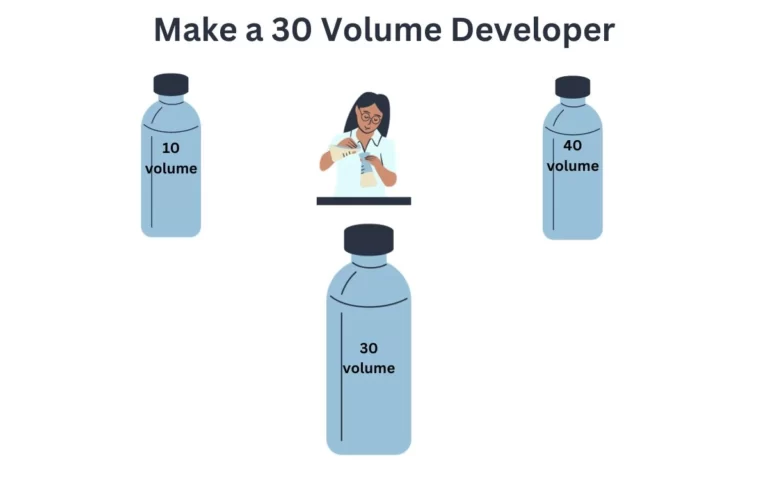Can You Bleach Permed Hair Safely? A Quick Guide
If you’ve recently had a perm to add texture, volume, or a fresh new look to your hair, you’re likely being extra cautious about the products you use to avoid damaging your curls or ruining their pattern.
But what if you’re eager to make your hair waves look more vibrant? Is it safe to bleach permed hair, or will it spell disaster for your locks?
After all, perming your hair takes a toll on your manes, and going for a bleach shortly afterward can be daunting. But what if I tell you that it’s possible to bleach permed hair safely and achieve stunning results?
Let’s try to understand what bleaching your permed hair will look like. Subsequently, I’ll explain the options you have to bleach your recently permed hair safely.
Can You Bleach Your Hair After A Perm?
The question of whether or not you can safely bleach your permed hair is a complex one, and there’s no one-size-fits-all answer. It depends on various factors that should be considered carefully before deciding.
1. Hair Strength: The Most Crucial Factor
The strength and health of your hair after a perm is the most critical factor to consider when deciding whether or not to bleach your hair.
If your hair is still strong and healthy after the perm, you can safely bleach it without causing too much damage.
However, if your hair is already weak or damaged from the perm, you’ll need to evaluate a few other factors before deciding to bleach it.
To test elasticity, gently stretch a strand of hair when it’s wet. Healthy hair should stretch up to 50% of its original length and then return to its natural state without breaking.
You can check the health of your hair by judging its porosity. The lower the hair porosity, the smoother and healthier your locks will be.
You might ruin your perm if you go for bleach on weak, fragile curls.
2. Consider The Timing Of Your Perm
Timing is key when it comes to bleaching permed hair!
I have seen a few people asking that they got their hair permed months ago, and now they want to get the bleach.
Certainly, if your hair has yet to go through any other chemical treatment since the perm, you can bleach your permed hair. But make sure your locks are still intact.
However, bleaching too soon after the perm can aggravate damage and lead to breakage, split ends, and other issues.
Giving your hair enough time to recover and strengthen after the perm is important before attempting to bleach it.
Generally, waiting at least two weeks before bleaching permed hair is best.
3. How Many Levels of Color Lift Do You Want?
Going too many levels lighter than your natural hair color can be risky, particularly if your permed hair is weak or damaged.
It’s important to consider how many levels of color lift you want to achieve with the bleach and whether this is a realistic goal for your hair type and condition.
| Developer Volume | Color Lift | Hair Type | Potential Hair Damage |
|---|---|---|---|
| 10 Volume | 0-1 level | All hair types | Minimal to no damage |
| 20 Volume | 1-2 levels | All hair types | Minimal to no damage |
| 30 Volume | 2-3 levels | Low Porosity Hair | Moderate damage |
| 40 Volume | 3-4 levels | Coarse & Resistant | Notable hair damage |
Unless it has been months since you got your hair perm or your locks are in good health, you should only go for 1-2 levels of color lift with the bleach.
If you want a higher-level color lift, let’s say you want to go blonde from your brown hair, you can go for two bleaching procedures at least ten days apart.
How Can You Bleach Permed Hair With Minimum Damage?
So, let’s say it has been a few weeks after you got your hair permed. Upon analyzing your hair health by doing the strand test, you found that your locks are not at their optimal strength.
In that specific case scenario, I have this 3-step guide that’ll help bleach your permed hair with no notable dryness and breakage.
1. Prepare Your Permed Hair For the Bleach
It is crucial for your hair to be at its optimal strength to sustain the aggressive action of bleaching. For this specific purpose, you can employ hair-strengthening treatments like Olaplex.
Olaplex is a popular hair treatment brand that helps to strengthen and repair damaged hair. Using Olaplex No. 3 before bleaching can help minimize damage caused by the bleach.
OLAPLEX No. 3 is a hair treatment product designed to strengthen and protect hair. It contains a patented active ingredient, Bis-Aminopropyl Diglycol Dimaleate, a unique molecule that helps to re-link broken disulfide bonds in the hair.
Just apply the recommended amount of it to your locks, ensuring each strand is covered. According to the Olaplex brand, No.3, the hair perfector should be left on your hair for at least 10 minutes.
People who let the Olaplex No.3 sit on their manes for 60-90 minutes experienced better results.
Applying it once or twice before bleaching your hair after getting a perm can strengthen the locks to a level that can sustain the aggressive chemical processing.
2. Employ a Lower Strength Developer For The Bleach
As mentioned above, unless your permed hair is in good health, you shouldn’t opt for a higher volume (30 or 40) developer that lifts your hair color for 3-5 levels.
A 40-volume developer contains 12% hydrogen peroxide and has the most aggressive action. Your hair loses more protective layer proteins and turns dry and unruly.
In the worst case scenario (if your is already weak due to perming), bleaching your permed hair can make your locks gummy less elastic.
So, it is crucial to consider the strength of your hair and the time since you got a perm before deciding on a 12% developer for the bleach.
If you plan to change your permed hair color to 3-4 levels, I suggest bleaching your manes in two steps, each separated by at least two weeks.
Use the Olaplex and protein treatments to recover your locks some strength.
So, whatever volume developer you have decided to employ for your permed hair, the next step will be minimizing the bleach damage.
3. Mix Olaplex No.1 in The Bleach
According to the Allure, you can directly mix Olaplex No. 1 into the bleach or dye mixture. The product reaches the hair strand’s core and has better action than usual.
Mixing Olaplex No. 1 into the bleach mixture is done to minimize damage during hair bleaching. The product strengthens disulfide bonds and reduces keratin loss from the hair.
To use it, first prepare the bleach mixture, then add Olaplex No. 1 to it at a 1:5 ratio. For example, if your bleach mixture is 40 ml, you will need 8 ml of Olaplex No. 1.
Mixing essential oils with bleach or getting your hair too greasy won’t help. Instead, it may cause inconsistent hair color lift.
4. Aftercare of Your Bleached & Permed Hair
Olaplex No. 2 is a hair treatment product designed to be used after a chemical treatment like bleaching or perming.
It works by repairing and strengthening the hair’s bonds, which can be damaged during these processes.
After bleaching permed hair, Olaplex No. 2 can be used as a follow-up treatment to help repair and strengthen the hair. Here’s how to use it:
- After the bleaching, rinse the hair thoroughly with gentle warm water.
- Apply Olaplex No. 2 to the hair, working it in from the roots to the ends. Make sure to saturate the hair thoroughly with the product.
- Leave it in the hair for at least 10 minutes. You can leave it in for longer, up to 45 minutes, for best results.
- Rinse the hair thoroughly with water, then shampoo and condition it as usual.
Wrapping Up
Doing two hair chemical processing procedures, including perming and bleaching, will be unwise because it can cause dryness and breakage. If you have recently permed your hair and now want to bleach it, there are a few things you should consider first.
It is safe to bleach permed hair if it is in good health. However, when your hair is weak, you must follow the steps I mentioned in this article to bleach your hair safely.
I hope it helps!








Hey there You have done a fantastic job I will certainly digg it and personally recommend to my friends I’m confident they’ll be benefited from this site